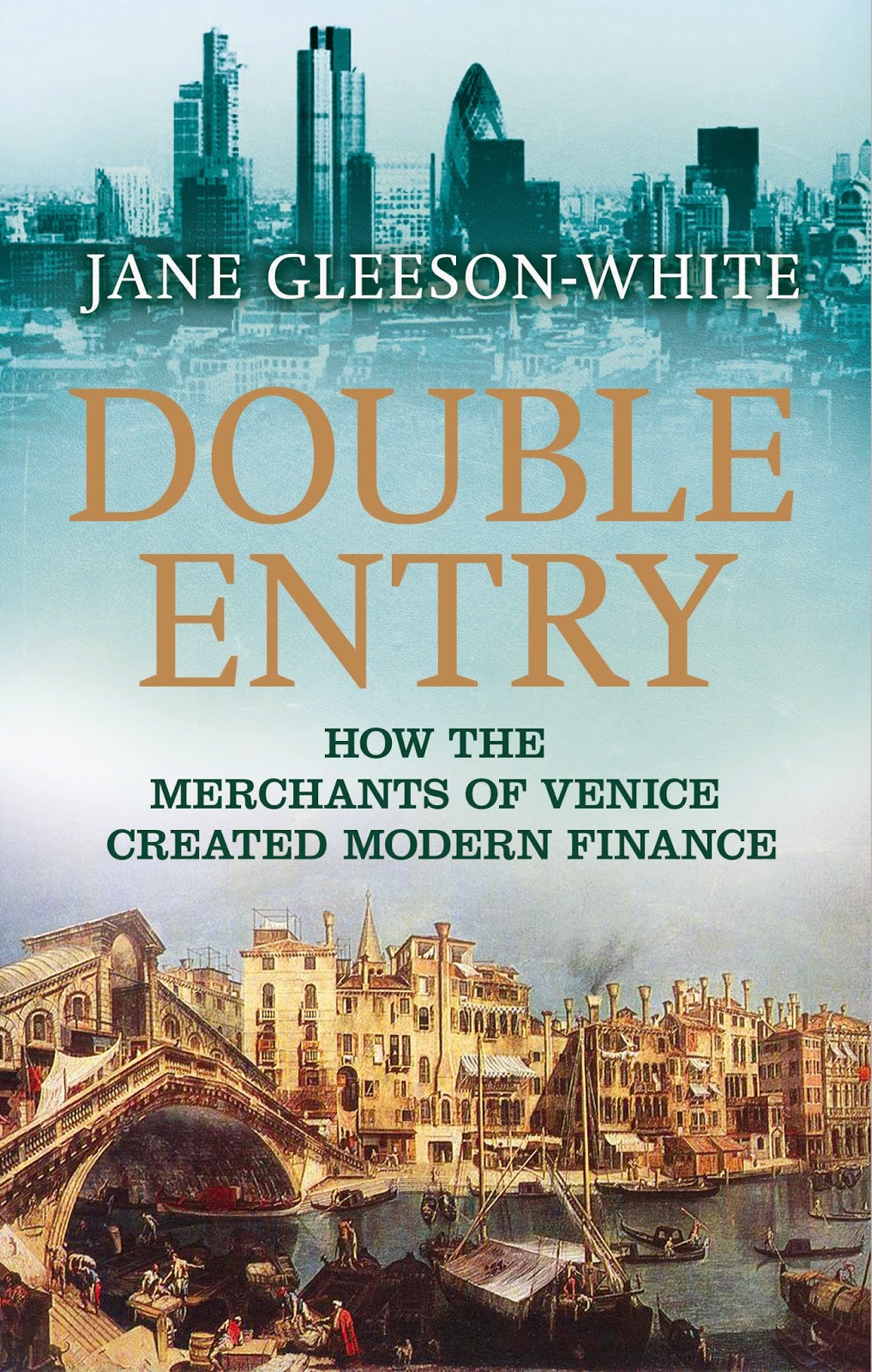(Venice, Italy) It was only a matter of time before someone like Jane Gleeson-White wrote a book subtitled "How the Merchants of Venice Created Modern Finance." If you live in Venice long enough, you start to feel the echoes of ancient Venezia reverberating throughout history straight up to the present day in nearly every aspect of life. Once the financial center of Europe, the center of international trade, and the capital of the publishing industry, Venice was the New York City of its day.
Double Entry is an engaging book about a seemingly boring topic:
accounting, and how the double-entry bookkeeping system rocked the world. The year was 1494, right around the time Christopher Columbus set his sights on America inspired by the Venetian explorer, Marco Polo -- a copy of
The Travels of Marco Polo with handwritten annotations was found in Columbus' possessions.
In Venice in 1494, a man named Luca Pacioli published a mathematical encyclopedia called
Summa de arithmetica, geometria, proportione et proportionalità, introducing Hindu-Arabic numbers to a wide audience in Italy for the first time thanks to new technology called the printing press. In Pacioli's encyclopedia was a treatise about the Venetian double entry system of accounting. Pacioli wrote in the vernacular, not Latin, and encouraged merchants to switch over from using Roman numerals and old arithmetic to the new system.
 |
| The Last Supper by Leonardo da Vinci (1494-98) |
After Pacioli's
Summa was published, it became a bestseller and he became famous. Leonardo da Vinci read it in Milan and asked Ludovico Sforza, the ruler of the realm, to summon Pacioli to his Court. So, off Pacioli went to Milan and met da Vinci, who was working on the
Last Supper. The two men were obsessed with geometry and arithmetic. Pacioli's next book was called
De divina proportione about the "divine proportion," or the golden ratio known as
phi, with 60 drawings by his pal Leonardo.
 |
Vitruvian Man by Leonardo da Vinci
The original drawing is here in Venice
in the Gabinetto dei disegni e delle stampe
of the Gallerie dell'Accademia, |
Gleeson-White describes Luca Pacioli as a "Renaissance mathematician,
monk, magician and constant companion of Leonardo da Vinci." In 1499, the army of Louis XII of France invaded Milan and destroyed Pacioli's mathematical models, believing they were the work of the devil. Pacioli and da Vinci escaped to Mantua where Isabella d'Este was taking refugees. Pacioli dedicated a book to Isabella called
De viribus quantitatis ("On the Power of Numbers") which, to this day, has never been published and is in the Bologna University Library. Next, Luca and Leonardo went to Florence, where they shared a house.
Pacioli claimed to have written another book called
De Ludo Scacchorum, the first book about chess. It was called "Mad Queen's Chess," because it made the queen the most powerful piece on the board. In 2006, after missing for five centuries, Pacioli's surviving manuscript was discovered in Gorizia in the 22,000-volume library of Count Guglielmo Coronini, who said he had bought it in 1963 from a "Venetian poet and bibliophile". It is believed that da Vinci could have done the drawings because Isabella d'Este was a known chess player, and, as we can see, the boys were quite an item at the time.
With these mystical, magical beginnings, how did we arrive to a place in the world where corporate greed and corruption has managed to warp a formula that began as a way to keep merchants honest? Jane Gleeson-White takes us on a fascinating journey through the centuries with a compelling style that entertains even the number-challenged among us. When we grasp the concept of the Gross National Product and how it can be manipulated, today's world of Enrons and Big Banks and Wall Street clicks into place.
What was new to me is the term "Natural Capital," something that is slowly being taking into account at meetings around the globe. It means that Nature is finally going to be worth something. Right now, Nature is not worth anything in terms of profit and loss. Look at it this way: a friend of mine owns some property in the country. On her property is a small forest full of trees. Those trees are not worth anything unless she chops them down and sells the wood, or uproots them. My friend wanted more trees closer to the house and bought three new trees, which cost her €1,000. With Natural Capital, those old, majestic trees growing in her small forest would add value to the property that is not being taken into account today.
Or what about the value of waters of the Venice lagoon versus the exploitation by the cruise ships? Has the "Natural Capital" of the Venetian lagoon and all the riches it provides been tallied into the equation? On her
Bookishgirl blog, Jane Gleeson-White says, "The problem with our current accounting systems – both national and
corporate – is that they don’t account for natural capital, they don’t
value living nature, and so it is invisible."
Gleeson-White starts her book with a speech that Bobby Kennedy made on March 18, 1964 at Kansas State University, three months before he was assassinated:
"Too much and for too long, we seemed to have surrendered personal excellence and community values in the mere accumulation of material things. Our Gross National Product, now, is over $800 billion a year, but that Gross National Product... does not allow for the health of our children, the quality of their education or the joy of their play. It does not include the beauty of our poetry or the strength of our marriages, the intelligence of our public debate or the integrity of our public officials. It measures neither our wit nor courage, neither our wisdom nor our learning, neither our compassion nor our devotion to our country; it measures everything, in short, except that which makes life worthwhile."

























